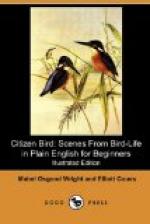It was the last week of the children’s stay at the shore before everything combined to make possible the sail to Gull Island. They had spent three glorious weeks, and were as ruddy brown as any of the little Indians who had once gathered wampum shells from the same beach in the long ago. They were wiser also in many ways, for they had found out many things for themselves—which is the very best sort of wisdom. Now even Dodo could tell by the footprints on the sand whether a three-toed Plover or a four-toed Sandpiper had been pattering there.
[Illustration: Hooded Merganser.]
When the right day came, without a sign of ugly squalls or of an equally unfortunate calm, Olaf borrowed a largo cat-boat, and after stowing away the lunch hamper, that was always a ‘must be’ for an all-day trip, the boat almost flew out of the little bay and up the sound before the breeze that came with the morning tide.
“There are some more of your white Crows, Nat,” said the Doctor, as they headed straight out after getting on the right tack. “The island where we are going is one of their famous nesting places.”
“Their wings are very different from Crows’ wings,” said Rap, as he watched them overhead, now winnowing the air with steady wing-beats, or circling on motionless pinions—now poising in one spot for a minute by merely flapping the wings, and then dropping gracefully to float on the water. “Gulls’ wings bend out more at the tip and are smooth-edged; Crows’ look flatter and are saw-edged.”
“Are there any other birds besides Gulls that nest on the island, Uncle Roy?” asked Nat.
“Yes, the Terns or Sea Swallows that you have seen about the reef nest there also; and this island, as well as the mainland near by, is a favorite stopping-place for all the shore and water birds in their journeys,—from Sandpipers to great flocks of Sea Ducks.”
“I should think it would be a long swim for Ducks,” said Nat; “it is as much as fifteen miles from shore.”
“They don’t swim—they fly there,” said Olaf.
“Can Ducks fly?” exclaimed Dodo in amazement. “I’m sure the white Ducks at the Farm can only waddle on the ground, or swim and spatter along the water when Wolf or Quick chases them for fun. And anyway their legs are very stiff and queer and grow very far back, as if their bodies were too heavy and going to fall down front, and they had to hold up their heads very high to keep going.”
“Our tame Ducks are very fat and lazy, for they have lived in captivity for many generations; yet they could fly very well with a little practice. The Mallard, which is a wild River Duck and a swift enduring flyer, is the one which has been domesticated and for hundreds of years kept as a barnyard Duck.”
“River Ducks?” questioned Rap; “then are there different kinds of Ducks for rivers and lakes, and for salt water?”
“There are indeed many kinds of Ducks,” said the Doctor, “all of which have easy marks of identification in the beauty-spot on the wings, and many other points about the plumage, as well as the different shapes of their heads, bills, and feet. Though all Wild Ducks, and Geese too, belong to one general family, they are divided into separate groups like cousins, instead of living in one household like brothers.




